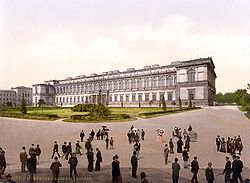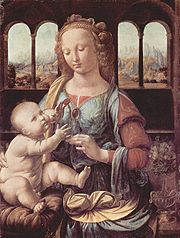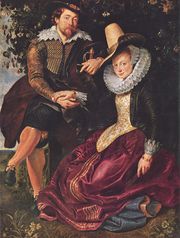Alte Pinakothek
| Alte Pinakothek | |
| Established | 1836 |
| Location | Munich (German: München), Germany |
| Collection size | old masters |
| Website | www.pinakothek.de |
The Alte Pinakothek (engl. Old Pinakothek) is an art museum situated in the Kunstareal in Munich, Germany. It is one of the oldest galleries in the world and houses one of the most famous collections of old master paintings. The name (old Pinakothek) alludes to the time period covered by the art — the Neue Pinakothek covers 19th century art and the recently opened Pinakothek der Moderne exhibits modern art, all galleries are part of Munich's "Kunstareal" (the "art area"). The museum is part of the Bavarian State Picture Collection (German: Bayerische Staatsgemäldesammlungen), an organization of the Free state of Bavaria.
Contents |
The building
King Ludwig I of Bavaria (1825-1848) ordered Leo von Klenze to erect a new building for the gallery for the Wittelsbach collection in 1826. The museum galleries were designed to display Rubens's "Last Judgment" (1617), one of the largest canvasses ever painted. Very modern in its day, the building became exemplary for museum buildings in Germany and all of Europe after its inauguration in 1836, and thus became a model for new galleries in Rome, St Petersburg, Brussels and Kassel.
The museum building was severely damaged by bombing in World War II but was reconstructed and reopened to the public in the late 1950s. The ornate, pre-war interior was not restored.
History

The Wittelsbach collection was begun by Duke Wilhelm IV (1508-1550) who ordered important contemporary painters to create several history paintings. Elector Maximilian I (1597-1651) acquired paintings, especially the work of Albrecht Dürer. Maximilian's grandson Maximilian II Emanuel (1679-1726) purchased a large number of Dutch and Flemish paintings when he was Governor of the Spanish Netherlands. Also his cousin Johann Wilhelm, Elector Palatine (1690-1716) collected Netherlandish paintings. By the late 18th century a large number of the paintings were already displayed in an old palace, and accessible to the public.
After the reunion of Bavaria and the Palatinate in 1777, the galleries of Mannheim, Düsseldorf and Zweibrücken were moved to Munich, in part to protect the collections during the wars which followed the French revolution. With the secularisation many paintings from churches and former monasteries entered into state hands. King Ludwig I of Bavaria collected especially Early German and Early Dutch paintings but also masterpieces of the Italian renaissance.
The predilection of the Wittelsbach rulers for some painters made the collection quite strong in those areas but neglected others. Since the 1960s the Pinakothek has filled some of these gaps: for example, a deficit of 18th century paintings was addressed by the integration into the collection of works loaned from two Bavarian banks. Among others these paintings include Lancret's "The Bird Cage" and Boucher's "Madame Pompadour."
Collection

The museum is under supervision of the Bavarian State Picture Collection which own also an expanded collection of several thousand European paintings from the 13th to 18th century. Especially its collection of Early Italian, Old German, Old Dutch and Flemish paintings belongs to the most important in the world. More than 800 of these paintings are exhibited in the Old Pinakothek. Due to limited space in the building some associated galleries throughout Bavaria such as the baroque galleries in Schleissheim Palace and Neuburg Palace display also the Old Masters.
- German paintings 14th–17th century:
- Among many others the Pinakothek shows works of Stefan Lochner ("Adoration of the Christ Child by the Virgin (The Nativity)"), Albrecht Dürer ("The Four Apostles", "Paumgartner Altar", "Self-portrait in Fur Coat"), Hans Baldung Grien ("Markgrave Christoph of Baden"), Albrecht Altdorfer ("The Battle of Issus"), Cranach ("Lamentation Beneath the Cross"), Holbein ("St. Sebastian Altar; Central panel: Martyrdom of St. Sebastian"), Matthias Grünewald ("SS. Erasmus und Maurice"), Michael Pacher ("Altar of the Church Fathers"), Hans von Aachen ("The Triumph of Truth"), Adam Elsheimer ("The Flight into Egypt"), Johann Liss ("Death of Cleopatra")
- Early Netherlandish and Dutch paintings 15th–18th century:
- One of the most impressive collections worldwide especially for Early Netherlandish paintings with masterpieces for example of Rogier van der Weyden ("Columba Altar"), Dieric Bouts ("Ecce Agnus Dei"), Lucas van Leyden ("Virgin and Child with Mary Magdalen and a Donor"), Hieronymus Bosch ("Fragment from the Last Judgment"), Rembrandt van Rijn ("The Deposition", "The Holy Family"), Frans Hals ("Portrait of Willem Croes"), Pieter Lastman ("Odysseus and Nausikaa"), Carel Fabritius ("Self-Portrait"), Gerard Terborch ("The Flea-Catcher (Boy with His Dog)") and Jacob van Ruisdael ("Torrent with Oak Trees")
- Flemish paintings 16th–18th century:
- The collection contains masterpieces of painters like Jan Mabuse ("Danae"), Pieter Brueghel the Elder ("Harbour Scene with Christ Preaching", "The Land of Cockaigne"), Hans Memling ("The Seven Joys of the Virgin" ), Jan Brueghel the Elder ("Harbour Scene with Christ Preaching"), Peter Paul Rubens ("Rubens and Isabella Brant in the Honeysuckle Bower") ("The Fall of the Damned") ("The Big Last Judgment"), van Dyck ("Self-Portrait", "Susanna and the Elders"), Jacob Jordaens ("Satyr with Peasants") and Adriaen Brouwer ("Village Barbar's Shop"). The Rubens Collection is the largest one worldwide.

- Italian paintings 13th–18th century:
- The Italian Gothic paintings are the oldest of the gallery, among them Giotto's famous "The Last Supper", then all Schools of Italian Renaissance and Baroque Painting are represented with works of Fra Angelico ("Entombment of Christ"), Domenico Ghirlandaio ("Virgin and Child with SS. Dominici, Michael, John the Baptist and John the Evangelist"), Sandro Botticelli ("Lamentation of Christ"), Fra Filippo Lippi ("The Annunciation"), Lorenzo Lotto ("The Mystic Marriage of St. Catherine"), Raphael ("The Canigiani Holy Family") ("Madonna della tenda"), ("Madonna Tempi"), Leonardo da Vinci ("Madonna of the Carnation"), Antonello da Messina ("Annunciata"), Titian ("Vanity") ("Charles V"), Tintoretto ("Christ in the House of Mary and Martha"), Guido Reni ("The Assumption of the Virgin"), Luca Giordano ("A cynical philosopher"), Tiepolo ("The Adoration of the Kings"), Francesco Guardi ("Regatta on the Canale della Guidecca"), Canaletto ("Piazetta in Venice") and others.
- French paintings 16th–18th century:
- In spite of the close relationship of the Wittelsbach to France it is the second smallest section with works for example of Claude Lorrain ("The Expulsion of Hagar"), Nicolas Poussin ("Midas and Bacchus"), François Boucher ("Madame de Pompadour") ("Reclining Girl"), Nicolas Lancret ("The Bird Cage"), Jean-Baptiste-Siméon Chardin ("Woman Cleaning Turnips"), Maurice-Quentin de la Tour ("Mademoiselle Ferrand Meditating on Newton"), Claude Joseph Vernet ("Eastern Harbour at Dawn") and Jean-Honoré Fragonard ("Girl with Dog").
- Spanish paintings 16th–18th century:
- Though this is the smallest section all masters are represented, such as El Greco ("The Disrobing of Christ"), de la Cruz ("Infant Isabella Clara Eugenia of Spain"), Velazquez ("Young Spanish Gentleman"), Jusepe de Ribera ("Saint Bartholomew"), Zurbarán ("The Entombment of St. Catharine of Alexandria on Mount Sinai") and Murillo ("Baggar Boys Eating Grapes and Melon"). The paintings of Francisco de Goya were moved into the New Pinakothek.
Gallery
Selected pieces:
 Albrecht Altdorfer's "The Battle of Issus" |
 Adam Elsheimer's "The Flight into Egypt" |
 Raffael's "Madonna Tempi" |
 Tizian's "Vanity" |
 Rembrandt van Rijn's "The Sacrifice of Isaac" |
 Gerard ter Borch's "The Flea-Catcher" |
 Anthony van Dyck's "Self Portrait" |
 Peter Paul Rubens's "Rubens and Isabella Brant in the Honeysuckle Bower" |
 Juan Pantoja de la Cruz's "Infanta Isabella Clara Eugenia" |
 Murillo's "Baggar Boys Eating Grapes and Melon" |
_Midas_and_Bacchus.jpg) Nicolas Poussin's "Midas and Bacchus" |
 François Boucher's "Reclining girl" (Marie-Louise O'Murphy, 1737-1818) |
External links
|
|||||||||